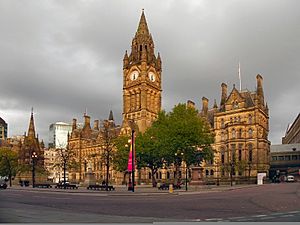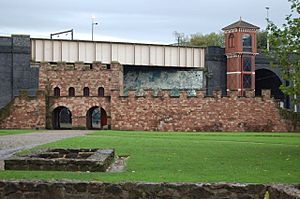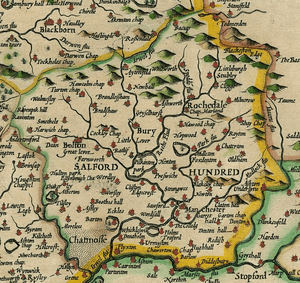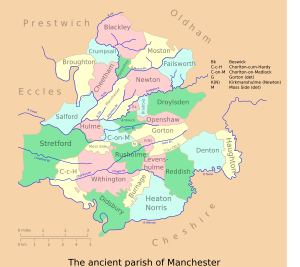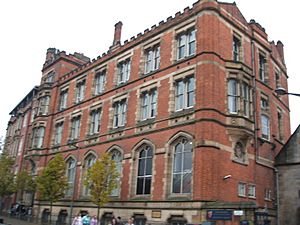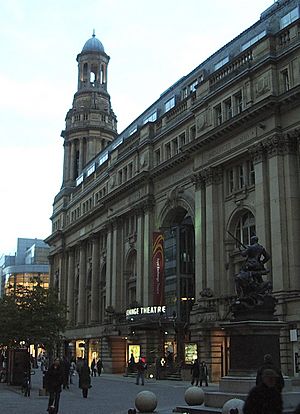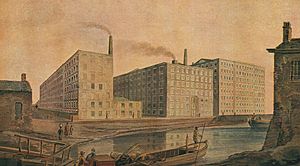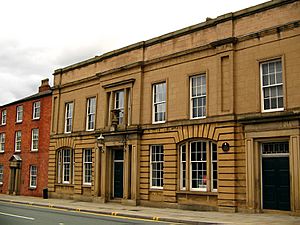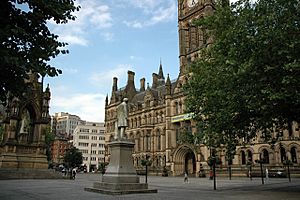History of Manchester facts for kids
The history of Manchester tells the story of how this city changed from a small town in Lancashire into a major industrial hub for the United Kingdom and the world. Around the 1800s, Manchester grew incredibly fast. This happened because of a huge increase in making textiles (like cloth) during the Industrial Revolution. This big change took just over 100 years.
Manchester started as a Roman fort in Celtic Britain. Later, in the Victorian era, it became a key place during the Industrial Revolution. It was home to one of the world's first passenger railway stations and many important scientific discoveries. Manchester also led the way in political and economic changes in 19th-century Britain, pushing for free trade.
In the mid-1900s, Manchester's industrial importance declined. This led to tough social and economic times. But from the 1990s onwards, new investments and changes helped the city bounce back. Manchester became a modern city with important sports, broadcasting, and educational places.
Manchester has often been considered for UNESCO World Heritage City status. However, after the 1996 bombing, local leaders focused more on economic growth than on preserving the past. For example, the 558-foot (170-metre) Beetham Tower was built. Some say this building ended any chance of World Heritage City status. Still, important areas from the Industrial Revolution, like Castlefield and Ancoats, have been carefully redeveloped.
Contents
- What's in a Name?
- Early History
- Roman Times
- After the Romans Left
- Medieval Manchester
- Textile Trade Grows
- The Industrial Revolution Begins
- Getting Around Manchester
- People of Manchester
- Ideas and Culture
- Making Changes
- Growth and Culture
- 20th Century Manchester
- Manchester in the 21st Century
- How Manchester is Governed
- Greater Manchester Area
- See also
What's in a Name?
The name Manchester comes from the Latin name Mamucium or Mancunio. These names likely came from an older Brittonic (Celtic) name. Many believe it comes from the Brittonic word *mamm- meaning "breast". This might refer to a "breast-like hill".
However, some newer ideas suggest it could come from *mamma meaning "mother". This might refer to a local river goddess. The ending -chester comes from an old English word for "Roman fort" (from the Latin castra).
Early History
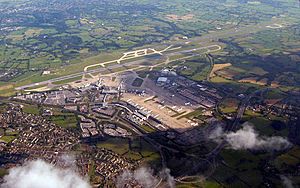
We don't have much proof of human activity in the Manchester area before the Romans. Only a few stone tools have been found.
There is evidence of people living here during the Bronze Age, shown by burial sites. Some old items have been found in the city centre. But these items might have been moved from other places. More evidence of early activity has been found in other parts of the area. Before the Roman invasion of Britain, the area belonged to the Brigantes. This was a Celtic tribe. It might have been controlled by the Setantii, a smaller group of the Brigantes.
Roman Times
The Roman fort of Mamucium was built around 79 AD. It was near a place where people could cross the River Medlock. The fort was on a high sandstone cliff. This was a good spot for defense, near where the Medlock and Irwell rivers met.
Gnaeus Julius Agricola built it during his fight against the Brigantes tribe. This tribe controlled most of what is now northern England. The fort protected the Roman road from Deva Victrix (Chester) to Eboracum (York). Another road went north to Bremetennacum (Ribchester). Nearby forts were Castleshaw and Northwich.
The first fort was made of earth and wood. It was torn down around 140 AD. When it was rebuilt around 160 AD, it was again made of earth and wood. Around 200 AD, the fort was rebuilt again. This time, its defenses were made stronger with stone walls and a stone gatehouse. About 500 auxiliary soldiers would have lived in the fort.
People have found signs of both pagan and Christian worship. Two altars have been found. There might have been a temple for Mithras near Mamucium. A word puzzle was found in the 1970s. This might be one of the earliest signs of Christianity in Britain.
A civilian settlement, called a vicus, grew up next to the fort. It was home to traders and soldiers' families. One area with many furnaces and industrial work has been called an industrial estate. The vicus was probably left empty by the mid-3rd century. However, a small group of soldiers might have stayed at Mamucium until the late 3rd and early 4th centuries. The Castlefield area of Manchester is named after this old fort.
After the Romans Left
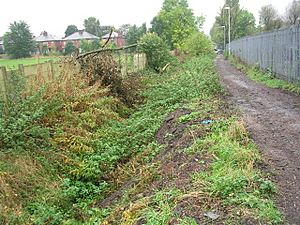
After the Romans left Britain, people started to settle where the Irwell and Irk rivers met. During the Early Middle Ages, Manchester was part of different kingdoms. In the late 500s and early 600s, the kingdom of Northumbria reached as far south as the River Mersey.
Old place names show that areas north-west of Manchester (like Eccles) were British. Parts of Manchester itself (like Clayton) were Anglian. The south-west of Manchester was Danish (like Cheadle Hulme).
Between the 6th and 10th centuries, the kingdoms of Northumbria, Mercia, and Wessex fought for control of North West England. In 620, Edwin of Northumbria might have attacked Manchester. The settlement might have been attacked again in 870 by the Danes.
Legend says that Nico Ditch was dug in 869–870 to defend against Viking invaders. This ditch runs from Ashton-under-Lyne to Stretford. We don't know if the legend is true, but the ditch was built between the 7th and 9th centuries. The Anglo Saxon Chronicle says that in 919, Edward the Elder sent men to Mameceaster to fix and staff it. This probably means a fort in Manchester. It was an advanced post for Mercia. This might refer to the old Roman fort.
The ancient parish of Manchester was much larger than today's city. It was probably set up in the Anglo-Saxon period. It had only two churches: one in Manchester and one in Ashton-under-Lyne. Forty different townships grew in the parish. In medieval times, the royal manor of Salford was the most important.
Medieval Manchester
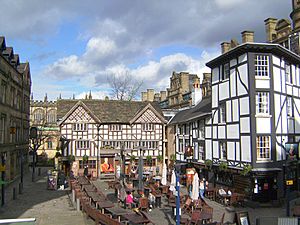
Manchester was part of the Salford Hundred. In 1086, this area was about 350 square miles (910 km2) and had about 3,000 people. It was given to Roger de Poitou. Roger divided the area into smaller parts, and the Gresle family became barons of Manchester. Albert de Gresle was the first baron. Even though the Gresle family didn't live in Manchester, the town kept growing.
The Domesday Book mentions Manchester. It says "the Church of St Mary and the Church of St Michael hold one carucate of land in Manchester free from all dues except tax." St Mary's Church was an Anglo-Saxon church where Manchester Cathedral is now. St Mary's Church was the religious center of the Salford Hundred. It covered about 60 square miles (160 km2).
There was a castle in Manchester overlooking the Irk and Irwell rivers. This is where Chetham's School of Music stands today. This castle was probably a simple fort and not very important for politics or war. By the late 1200s, the Grelleys (or Gresles) replaced the castle with a fortified manor house. They used this house to manage the area.
The first lord of the manor to actually live in Manchester was Robert Grelley (1174–1230). His arrival brought skilled workers like stonemasons and carpenters to build the manor house. In the early 1200s, Manchester was briefly not controlled by the Grelleys. Robert Grelley was one of the barons who made King John sign Magna Carta.
Medieval Manchester grew into a market town with a market every Saturday. In 1223, Manchester got the right to hold an annual fair. The market was held in Acresfield, which is now St Ann's Square. Manchester officially became a market town in 1301 when it received its Charter.
The town's medieval defenses used the Irk and Irwell rivers on two sides. On the other sides, there was a 450-yard (410 m) long ditch called Hanging Ditch. It was up to 40 yards (37 m) wide and deep. Hanging Bridge crossed this ditch. This bridge was the main way into and out of the town. It dates back to at least 1343.
In the 1300s, Flemish weavers came to Manchester. They settled in the town to make wool and linen. This helped the region become known for cloth production. This, in turn, helped Manchester grow into Lancashire's main industrial center.
Thomas de la Warre, a Lord of the Manor and a priest, founded a collegiate church in Manchester. It was dedicated to the Blessed Virgin, St. George, and St. Denys. Construction started around 1422 and continued until the early 1500s. Wealthy merchants in the town funded several small chapels. This showed the town's growing wealth from wool. This church later became Manchester Cathedral.
Thomas also gave the old manor house as a home for the priests. This building is now Chetham's School of Music. It is one of the best examples of a medieval religious building in Britain.
Textile Trade Grows
By the 1500s, the wool trade made Manchester a busy market town. The collegiate church, now the cathedral, was finished between 1500 and 1510. The beautiful carved choir stalls are from this time. In 1513, work began on a chapel funded by James Stanley, a bishop. He built it to thank God for his relative, John Stanley, returning safely from the Battle of Flodden.
The English Reformation changed the collegiate church into a Protestant church. One famous leader of this church was Dr John Dee, known as "Queen Elizabeth's Merlin."
The town grew even more in 1620 when fustian weaving began. Manchester grew a lot during this time because many Flemish settlers arrived. They started Manchester's new weaving industry. In the 1600s, Manchester became a strong center for puritanism. This was thanks to the textile industry and connections with London.
Because of this, Manchester sided with Parliament in the fight against King Charles I. Some even say the English Civil War started here. In 1642, Lord Strange, a Royalist, tried to take the militia's weapons stored in the old college building. In the fight, Richard Percival, a linen weaver, was killed. Some believe he was the first person to die in the English Civil War.
Lord Strange returned and tried to attack the town, which had no strong defenses. With help from John Rosworm, a German soldier, the town defended itself strongly. Captain Bradshaw and his soldiers bravely held the bridge to Salford. Eventually, Strange realized his forces were not ready. After hearing his father had died, he left to claim his title.
During the English Commonwealth, Manchester was given a seat in Parliament for the first time. Maj Gen Charles Worsley, a trusted helper of Oliver Cromwell, became Manchester's first MP. He didn't stay long before Parliament was dissolved again. This led to the Rule of the Major Generals, which was like martial law. Worsley was in charge of Lancashire, Cheshire, and Staffordshire. He took his job seriously, closing pubs, banning bear baiting, and stopping Christmas celebrations. He died in 1656.
When the English Restoration happened in 1660, Manchester lost its MPs. This was punishment for supporting Parliament. Manchester didn't have an MP again until 1832.
Humphrey Chetham bought the old college buildings after the civil war. He turned them into a bluecoat school. Chetham's Hospital, as it was known, later became Chetham's School of Music. It also included a collection of books. In 1653, this became Chetham's Library, the first free public library in the English-speaking world. It is still open and free to use today.
Despite political problems, the town continued to do well. Many people supported the Glorious Revolution in 1688. They were unhappy with the Tory clergy at the collegiate church. So, Lady Ann Bland founded a separate church. St Ann's Church is a beautiful example of an early Georgian church. It was opened in 1712. The area around it, now St Ann's Square, was designed like a London square.
Around this time, Daniel Defoe called Manchester "the greatest mere village in England." He meant that a place the size of a busy market town had no real local government. It was still controlled by the whims of a lord of the manor.
In 1745, Charles Edward Stuart and his army marched through Manchester on their way to London. Even though the town had been rebellious before, it didn't fight back. The Jacobites even found enough new soldiers to form a 'Manchester Regiment'. This might have been because the town had no local government. The magistrates, who could have organized resistance, were mostly conservative landowners. Also, these landowners had started training their sons to be Manchester merchants. So, the town's leaders had changed.
The Jacobite army only got as far as Derby and then retreated. On their way back through Manchester, people threw things at the stragglers. The 'Manchester Regiment' was left behind to guard Carlisle. They quickly gave up to the British Army.
The Industrial Revolution Begins
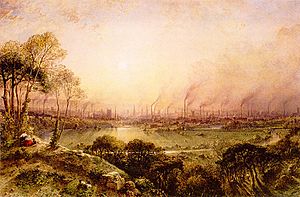
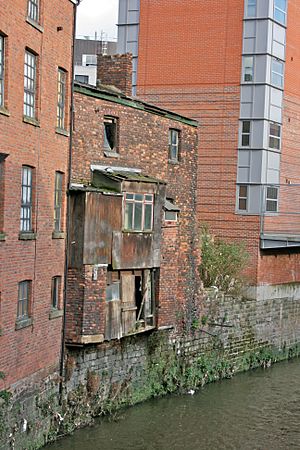
Manchester was a small market town until the late 1700s. Then, the Industrial Revolution began. The Spinning Jenny in 1764 started this revolution. It brought the first fully machine-powered production. The many small valleys in the Pennine Hills to the north and east of the town, along with the damp weather, were perfect for building water-powered cotton mills. An example is Quarry Bank Mill. These mills made spinning and weaving cloth much faster.
The import of cotton towards the end of the 1700s truly changed the textile industry here. This new material came through the port of Liverpool. Liverpool was connected to Manchester by the Mersey and Irwell Navigation. These two rivers had been made suitable for boats from the 1720s.
Manchester became the natural place to distribute raw cotton and spun yarn. It also became a market and distribution center for the growing textile industry. Richard Arkwright is known for building the first cotton mill in the city. He first tried using a Newcomen steam engine to pump water for a waterwheel, but it failed. Then, he changed a Watt steam engine to power the machines directly. This led to many cotton mills quickly appearing in Manchester and nearby towns. There were also bleach works, textile printing factories, and engineering workshops. All of these served the cotton industry. By the mid-1800s, Manchester was the center of Lancashire's cotton industry. It was called "Cottonopolis". A branch of the Bank of England was set up in 1826.
The city had one of Europe's first telephone exchanges. It opened in 1879 on Faulkner Street. By 1881, it had 420 users. Just seven years later, a new exchange could handle 10 times that number. Manchester Central exchange was the largest outside London in Edwardian times. It employed 200 operators. The city played several other important roles in the history of telephones.
Getting Around Manchester
As the city grew, its transport links also expanded. The rise of steam power meant a huge demand for coal. To meet this, the first canal of the industrial era, the Duke's Canal (also called the Bridgewater Canal), opened in 1761. It connected Manchester to the coal mines at Worsley. This canal was soon extended to the Mersey Estuary. Soon, a large network of canals was built, connecting Manchester to all parts of England.
One of the world's first public bus services started in 1824. It ran from Market Street in Manchester to Pendleton and Salford.
World's First Steam Passenger Railway
In 1830, Manchester was again a leader in transport technology. The Liverpool and Manchester Railway opened. This was the world's first steam passenger railway. It made it faster to move raw materials and finished goods between the port of Liverpool and the mills of Manchester. By 1838, Manchester was connected by rail to Birmingham and London. By 1841, it was connected to Hull.
The existing horse-drawn bus services were all bought by the Manchester Carriage Company, Ltd in 1865. Horse-drawn trams started in Salford (1877) and Manchester (1880–81). Electric trams replaced them in 1901–03. By 1930, Manchester Corporation Tramways had the third largest tram system in the UK.
People of Manchester
The Industrial Revolution caused Manchester's population to grow rapidly. People moved from other parts of the British Isles to the city looking for new chances.
Many people came from Ireland, especially after the Great Famine of the 1840s. In 1851, about 15% of Manchester's population was born in Ireland. The first Irish community in the city started in 1798. More waves of Irish immigration came after the Second World War. The Irish influence continues today. Every March, Manchester hosts a large St Patrick's Day parade. It's thought that about 35% of people in Manchester and Salford have some Irish family history.
Scottish people also moved to Manchester. Their numbers peaked in 1871, making up almost 2% of the city's population. Many of the city's machine-making companies, which powered the Industrial Revolution, were started by Scottish engineers.
A Welsh community has been in Manchester since the 1500s. In 1892, there were 80,000 Welsh-born people in North West England. Many were in Manchester and Liverpool. David Lloyd George, a famous Welsh socialist, was born in the city.
Later, many immigrants (mostly Jewish) came to Manchester from Central and Eastern Europe. Today, the area around Broughton, Prestwich, and Whitefield has about 40,000 Jewish people. This is the largest Jewish community outside London. Other groups included people from the Levant (involved in the Egyptian cotton trade), Germans, and Italians. The German influence can be seen in the city's Hallé Orchestra. The Ancoats area was known as Little Italy. By the early 1900s, Manchester was a very diverse place. It had also received immigrants from France, Greece, Armenia, Lithuania, Poland, and Ukraine. The opening of the Manchester Ship Canal in 1894 brought workers from Africa, Asia, the Middle East, and Scandinavia.
Black people have been in Manchester since the 1700s. Records show black people were buried at Manchester Cathedral from 1757. The abolitionist Thomas Clarkson noted in 1787, "I was surprised also to find a great crowd of black people standing round the pulpit. There might be forty or fifty of them."
From the 1940s onwards, more immigrants arrived. These included Cypriots and Hungarians fleeing conflict. But the largest numbers came from the British Colonies in the Indian subcontinent, the Caribbean, and Hong Kong. There has been a Chinese community in the city since the early 1900s. Chinatown, Manchester is said to be the second largest in the UK and the third largest in Europe.
From the 1990s onwards, people from Kosovo, Afghanistan, Iraq, and the Congo have settled here.
Because of all these periods of immigration, Manchester is thought to be one of the most diverse British cities, second only to London.
Ideas and Culture
Manchester's diverse population encouraged a lively intellectual and artistic life. The Manchester Academy, for example, opened in Mosley Street in 1786. It was originally run by Presbyterians. It was one of the few academies that offered higher education to religious nonconformists. These people were not allowed into the universities of Oxford and Cambridge. It taught classics, radical theology, science, modern languages, and history. In the arts, the Hallé Orchestra was supported by the German community in its early years.
Manchester's fast growth into a major industrial center meant changes happened quickly and sometimes felt scary. At that time, it seemed like anything could happen there. New industrial processes, new ways of thinking (like the 'Manchester School' promoting free trade), new social groups, new religious groups, and new ways for workers to organize. This spirit of change led to the opening of the Free Trade Hall. It attracted educated visitors from all over Britain and Europe. People said, "What Manchester does today, the rest of the world does tomorrow." Benjamin Disraeli, a young novelist then, wrote that Manchester was "as great a human exploit as Athens."
Making Changes
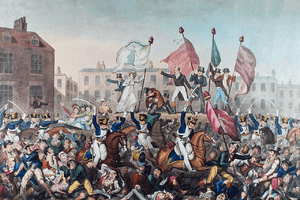
At the start of the 1800s, Manchester was still run by an old medieval system. A Boroughreeve was in charge of law and order during the day. The Manchester and Salford Police Act 1792 created police commissioners. Their job was to provide a night-watch. They were also responsible for building roads, cleaning streets, street lighting, and maintaining fire engines.
The late 1700s saw the first serious downturn in the textile trade. There were food riots in 1797. Soup kitchens were set up in 1799. Manchester was the scene of the Blanketeer protests in 1817. People were unhappy, and Manchester also lacked representation in Parliament. So, the town quickly became a center for radical protests.
The protests turned violent in the summer of 1819. A meeting was held in St Peter's Field on August 16 to demand parliamentary reform. Henry Hunt, a powerful speaker, addressed the crowd. Local officials, scared by the large crowd (estimated at 60,000–80,000), ordered volunteer cavalry to clear a path to arrest Hunt. The cavalry used swords and started hitting people in the crowd. The officials then ordered the 15th Hussars to break up the crowd. They charged into the people, using their swords. This resulted in 15 deaths and over 600 injuries. The event was immediately called "Peterloo" by a local newspaper. It combined the name of the meeting place, St Peter's Field, with the Battle of Waterloo fought four years earlier.
The Manchester Guardian, a newspaper with a radical viewpoint, was started soon after. In 1832, after the Great Reform Act, Manchester elected its first MPs since 1656. Liberals Charles Poulett Thomson and Mark Philips were elected. The Great Reform Act led to conditions that allowed Manchester to become a municipal borough in 1838. The remaining manorial rights were later bought by the town council.
Growth and Culture
The wealth from the textile industry helped Manchester and the surrounding areas grow. Many important places were built, including Belle Vue Zoological Gardens (1836), the Manchester Athenaeum (1836–37), the Corn Exchange (1837), and the Royal Victoria Gallery of Practical Science (1840–42).
This wealth also fueled the development of science and education. A Mechanics' Institute, which later became UMIST, was founded in 1824 by people like John Dalton, known as the "father of atomic theory." In 1851, Owens College was founded. It later became the first college of the Victoria University, which received its Royal Charter in 1880. This period saw a flourishing of new ideas and reforms in Manchester's cultural and intellectual life. John Dalton gave talks on his atomic theory at the Literary and Philosophical Society in 1803. The opening of the Portico Library in 1806, the Royal Manchester Institution (later the Art Gallery) in 1823, and the Manchester Botanical and Horticultural Society in 1827 show this growth.
City government continued to grow. Manchester officially became a borough in 1838. This included the township of Manchester (now the city centre), along with Ardwick, Beswick, Cheetham, Chorlton-on-Medlock, and Hulme.
In 1841, Robert Angus Smith started working as a chemist at the Royal Manchester Institution. He began researching the new environmental problems. Smith later became the first director of the Alkali Inspectorate. He also named and described acid rain.
Manchester continued to be a center of political change. From 1842 to 1844, the German social philosopher Friedrich Engels lived there. He wrote his important book Condition of the Working Class in England (1845). He often met Karl Marx at Chetham's Library.
In 1846, the Borough bought the manorial rights from the Mosley family. Manchester was granted city status in 1853.
By 1853, Manchester had 108 cotton mills, its highest number ever. Warehouses became common in what is now the city center. These 19th-century Manchester warehouses were often fancy and decorated, even for simple buildings. The most famous 19th-century warehouse is Watts Warehouse on Portland Street.
The Cooperative Wholesale Society was formed in 1863. Today, Manchester is home to the Co-operative Group. This is the largest mutual business in the world, with over six million members. The group is still based in its historic buildings in Manchester city center.
The start of the American Civil War in 1861 caused an immediate shortage of cotton. The resulting cotton famine brought great hardship to the area until the war ended in 1865.
The first Trades Union Congress was held in Manchester from June 2 to 6, 1868. Friedrich Engels wrote The Condition of the Working Class in England in 1844 about Manchester. Engels spent much of his life in and around the city. Manchester was also an important birthplace for the Labour Party and the Suffragette Movement.
Manchester's best time was perhaps the last quarter of the 19th century. Many great public buildings, including the town hall, were built then. The city's diverse atmosphere created a lively culture, including the Hallé Orchestra. In 1889, when county councils were created in England, Manchester became a county borough with even more self-rule.
In the late 1800s, Manchester's economy started to decline. This was partly because it relied on the Port of Liverpool, which charged high fees. Local industrialist Daniel Adamson led the effort to build the Manchester Ship Canal to fix this. It gave the city direct access to the sea. This allowed Manchester to export its goods directly. It no longer had to rely on railways and Liverpool's ports. When finished in 1894, it made Manchester Britain's third busiest port, even though it was 40 miles (64 km) inland. The Manchester Ship Canal was created by making the Rivers Irwell and Mersey navigable for 36 miles (58 km) from Salford to the Mersey estuary. This allowed ocean-going ships to sail right into the Port of Manchester (which is actually in Salford). The docks operated until the 1970s. Their closure led to a big increase in unemployment in the area.
World's First Industrial Estate
Trafford Park in Stretford (outside the city boundaries) was the world's first industrial estate. It still exists today, with many shops and entertainment places. Manchester suffered greatly from the economic downturn between the two World Wars. Old industries, like textile manufacturing, declined sharply.
20th Century Manchester
By 1900, the Manchester city region was the 9th most populated in the world. In the early 1900s, Manchester's economy became more diverse. It moved into engineering, chemical, and electrical industries. The ship canal helped create Trafford Park, the world's first industrial park, in 1910. Companies like the Ford Motor Company and Westinghouse Electric Corporation from the USA arrived. Their influence is still seen in "Westinghouse Road" and a grid of numbered streets.
In 1931, Manchester's population reached its highest ever, with 766,311 people. However, from the 1930s onwards, the population continuously declined. During this time, textile manufacturing, Manchester's main industry, sharply declined. This was largely due to the Great Depression of the 1930s and competition from other countries.
Important changes during this period included the Manchester Royal Infirmary moving from Piccadilly in 1908. Also, a new public library and town hall extension were built in the 1930s.
Second World War Impact
In the Second World War, Manchester was a key industrial city. The Avro aircraft factory (now BAE Systems) built many planes for the RAF. The most famous was the Avro Lancaster bomber. Because of its war efforts, the city was heavily bombed during the Blitz in 1940 and 1941. The Luftwaffe attacked it several times, especially in the "Christmas Blitz" of December 1940. This destroyed a large part of the old city center and badly damaged the cathedral. It took 20 years to restore. In total, 589 civilians died in Manchester due to enemy attacks.
After the War
The Royal Exchange stopped trading in 1968.
The 1950s saw Manchester begin its rise as a football powerhouse. Despite the Munich air disaster, Manchester United F.C. became one of the world's most famous clubs. They dominated English football from the early 1990s.
Mancunian Films was started by John E. Blakeley in the 1930s. It was a way to feature northern comedians like George Formby. The company opened its own studios, Dickenson Road Studios, in Manchester in 1947. It produced many successful films until Blakeley retired six years later. The studio was sold to the BBC in 1954. This was the same year commercial television started in the UK. The creation of Granada Television in the city attracted many talented people from the studios. This continued Manchester's tradition of cultural innovation, often with its unique social radicalism in its shows.
During the same period, local stars from the Granada TV soap opera Coronation Street became nationally famous. It first aired on ITV in December 1960 and is still on air more than 60 years later.
The city also gained international attention for the success of its two main football clubs: Manchester United and Manchester City.
Manchester United had won two league titles and an FA Cup in the early 1900s. But the years between the wars were difficult, with poor performance and financial problems. The club revived when Matt Busby became manager in 1945. He led the club to an FA Cup win in 1948 and a league title in 1952. He then built a very successful new team of mostly young players, nicknamed the Busby Babes. They won two more league titles and became the first English club to play in the new European Cup.
Then, tragedy struck in February 1958. Eight of the club's players died in the Munich air disaster. This happened on the return flight from a European Cup match in Yugoslavia. Two other players were so badly injured they never played again. Busby, who was seriously injured, had to build a new team. His new United team, built around Munich crash survivors like Bill Foulkes and Bobby Charlton, dominated English football in the 1960s. With new stars like Denis Law and George Best, they won two more league titles, an FA Cup, and then the European Cup in 1968. They were the first English club to win this trophy. Busby retired the next year after 24 years in charge. The club was less successful in the 1970s. Their only major trophy was the FA Cup in 1977. They even spent a season outside the top division. The 1980s were slightly better, with two more FA Cup wins and regular top-four league finishes. But the club has had unmatched success since Alex Ferguson became manager in 1986. By the time Ferguson retired in 2013 after 27 years, the club had won 13 more league titles, five FA Cups, four League Cups, and two European Cups. Famous players under Sir Alex Ferguson (knighted in 1999) include Bryan Robson, Mark Hughes, Ryan Giggs, Eric Cantona, David Beckham, and Wayne Rooney.
Manchester City joined the Football League in 1899. They won their first major honor, the FA Cup, in 1904. By 1939, Manchester City had been league champions once and FA Cup winners twice. They had more success after the war, starting with an FA Cup win in 1956. The club's next success came more than a decade later. They won a league championship in 1968, an FA Cup in 1969, and a double of the European Cup Winners' Cup and Football League Cup in 1970. This was under managers Joe Mercer and Malcolm Allison. Great players of the 1950s and 1960s included Don Revie, Bert Trautmann, Francis Lee, Colin Bell, and Tony Book. They won the League Cup in 1976. But after losing the 1981 FA Cup Final, the club declined. They were even relegated to the third tier of English football by the end of the 1997–98 season.
They have since been promoted back to the top tier in 2001–02. They have remained in the Premier League since 2002–03. For 80 years until 2003, the club played at the Maine Road stadium in Moss Side. Then they moved to the City of Manchester Stadium east of the city center. This stadium was built for the previous year's Commonwealth Games. In 2008, Abu Dhabi United Group bought Manchester City for £210 million. They invested a lot of money. The club's next major trophy was the FA Cup in 2011. The club's first top-division league title in 44 years followed in 2012. A League Cup triumph followed in 2014.
The club has now won seven domestic league titles. Under manager Pep Guardiola, they won the Premier League in 2018. They became the only Premier League team to get 100 points in a single season. In 2019, they won four trophies. This was an amazing sweep of all domestic trophies in England. They became the first English men's team to win the domestic treble. Manchester City's income was the fifth highest of any football club in the world in the 2017–18 season, at €527.7 million. In 2018, Forbes estimated the club was the fifth most valuable in the world at $2.47 billion.
Like many British cities during this time, the 1950s and 1960s saw Manchester undergo major redevelopment. Old and crowded housing was cleared. High-rise flats were built. This greatly changed Manchester's appearance. However, the high-rise experiment later became unpopular. The city center also saw big changes. Developments like the Manchester Arndale were built.
Manchester's key role in the Industrial Revolution was repeated. The city became a center for research and development. Manchester made important contributions to the computer revolution. The father of modern computing, Alan Turing, worked at Manchester University. His idea of the stored-program concept led to the Manchester Baby in 1948. This was the first electronic stored-program computer to run a program. Frederic C. Williams and Tom Kilburn at the University of Manchester developed it. This was followed by the Manchester Mark 1 in 1949. These inventions were later sold as the Ferranti Mark 1, one of the first computers available for sale.
In the late 1950s, Manchester was chosen to test a new telephone service. This service formed the basis of what we now call mobile phone technology. The "Post Office South Lancashire Radiophone Service" was controlled from the city's Peterloo telephone exchange. It allowed customers with special equipment in their vehicles to call any UK phone number.
In 1974, Manchester was separated from the county of Lancashire. The Metropolitan Borough of Manchester was created.
The city's economy became more diverse. This helped soften the impact of industrial decline. However, as more people owned cars and commuted, many moved from the inner-city to surrounding suburbs. By 1971, Manchester's population had dropped to 543,868. By 2001, it was 422,302.
IRA Bombing and Recovery
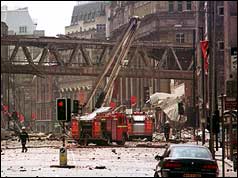
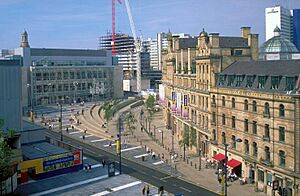
During the 1980s, many traditional industries declined. This was part of a big economic change known as Thatcherism. The city and region faced some tough times. The revival started towards the end of the decade. It was helped by growing wealth in the UK and by the creative music industry. New groups like Factory Records and Fac 51 Hacienda earned the city the nickname Madchester.
At 11:20 am on Saturday, June 15, 1996, the IRA set off a large bomb in the city center. It was the biggest bomb detonated on British soil. Luckily, warnings given an hour before allowed people to leave the area. So, the bomb caused over 200 injuries but no deaths. The main damage was to nearby buildings. Since then, the city center has been greatly rebuilt. This is part of wider efforts to improve previously run-down areas like Hulme and Salford.
This rebuilding led to a huge regeneration of the city center. Places like the Printworks and the Triangle created new shopping and entertainment areas. The rebuilding took over a decade. The renovated Manchester Arndale was finished in September 2006. It became the UK's largest city center shopping mall. The bomb is remembered by a plaque on a nearby postbox that survived the blast. It reads: "This postbox remained standing almost undamaged on June 15, 1996 when this area was devastated by a bomb. The box was removed during the rebuilding of the city centre and was returned to its original site on November 22nd 1999."
Manchester in the 21st Century
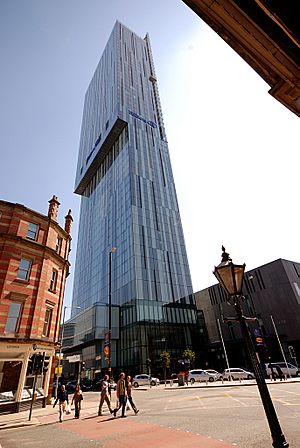
In 2002, Manchester successfully hosted the XVII Commonwealth Games. Many people who were doubtful before praised the city. Manchester had tried twice to host the Olympic Games but lost to Atlanta in 1996 and Sydney in 2000.
During the 1980s, the Victoria University of Manchester relied on its reputation as a leading red brick university. Meanwhile, many other universities grew and innovated. As a result, Manchester University's standing declined. Only in the 1990s did it start a "catch-up" program. In October 2004, the Victoria University of Manchester and UMIST merged. They formed the University of Manchester, the largest university in the UK. It has big plans to be one of the world's top research universities.
Since the rebuilding after the 1996 IRA bomb, and helped by the Commonwealth Games, Manchester's city center has changed a lot. Large parts of the city from the 1960s have been torn down and rebuilt or modernized with glass and steel. The Manchester Arndale is a good example of this change. Many old mills and textile warehouses have been turned into apartments. This has given the city a much more modern and upscale look. Some areas, like Hulme, have undergone big regeneration programs. Many expensive apartments have been built for the growing business community. The 168-meter tall, 47-story Beetham Tower, finished in 2006, has the highest homes in the UK. The lower 23 floors are the Hilton Hotel, while the upper 24 floors are apartments.
By 2011, Manchester and Salford were on a possible list for UNESCO World Heritage Site status. The proposal focuses on the Bridgewater Canal. This is seen as the first true canal that helped create the Industrial Revolution.
How Manchester is Governed
The town of Manchester was given a charter in 1301 by Thomas de Grelley. He was the Lord of the Manor of Manchester. But the town lost its borough status after a court case in 1359.
Until the 1800s, Manchester was one of many townships in the ancient parish of Manchester. This parish covered a wider area than today's city.
In 1792, commissioners, known as police commissioners, were set up to improve the Township of Manchester.
The Municipal Corporations Act 1835 changed many old boroughs into a new type called municipal boroughs. These had elected councils. Manchester used these new rules and got a charter to become a municipal borough on October 23, 1838. The borough created in 1838 included six townships: Ardwick, Beswick, Cheetham, Chorlton-on-Medlock, Hulme, and Manchester. The first election for the borough council was held on December 14, 1838. The council's first meeting was on December 15, 1838. Thomas Potter was appointed the first Mayor of Manchester. Joseph Heron was appointed the first town clerk.
On December 11, 1840, the Manchester Poor Law Union was officially declared. It took responsibility for managing and funding help for the poor in the area.
Becoming a City
On March 29, 1853, the borough was given city status. In 1885, more areas were added to the City of Manchester. These included Bradford, Harpurhey, Rusholme, and parts of Moss Side and Withington townships.
Under the Local Government Act 1888, the City of Manchester became a county borough in 1889. It kept its city title.
Other areas, which had been controlled by Lancashire County Council, were added to the city between 1890 and 1933. These included Blackley, Crumpsall, Moston, Openshaw, Newton, and parts of Clayton and Gorton. In 1903, part of Heaton Park was added. In 1904, Burnage, Didsbury, Chorlton-cum-Hardy, Moss Side, and Withington were added. In 1909, Levenshulme and the rest of Gorton were added. In 1933, part of Denton was added. In 1931, the Cheshire parishes of Baguley, Northenden, and Northen Etchells were also added.
Under the Local Government Act 1972, the City of Manchester, along with the civil parish of Ringway, became one of the ten Metropolitan Boroughs of the new Metropolitan county of Greater Manchester on April 1, 1974.
In 1986, the Greater Manchester County Council was abolished. Most of its jobs were given to the ten boroughs. This made them effectively unitary authorities. Some county council jobs were taken over by joint groups, like for transport, fire, police, and waste disposal.
In one of its most famous actions, Manchester City Council decided in 1980 to create the UK's first Nuclear Free Zone. The Peace Gardens were later built on a small piece of land in Lincoln Square.
Greater Manchester Area
Before 1974, the area of Greater Manchester was divided between Cheshire and Lancashire. Many parts were independent county boroughs. The area was unofficially known as "SELNEC," which stood for "South East Lancashire North East Cheshire." Also, small parts of West Riding of Yorkshire (around Saddleworth) and Derbyshire were included.
In 1969, a SELNEC Passenger Transport Authority was set up. It covered a smaller area than the proposed SELNEC.
Although a report proposing a larger SELNEC was rejected, the government still wanted local government reform. It agreed that a county based on Manchester was needed. Its first idea was much smaller than the report's SELNEC. But more areas like Wilmslow, Warrington, and Glossop were removed and put into other counties. The metropolitan county of Greater Manchester was finally established in 1974.
Greater Manchester's main county council was abolished in 1986. However, Greater Manchester is still a metropolitan county and ceremonial county.
|
See also
- Beyer, Peacock & Company
- History of England
- List of famous Mancunians
- List of railway stations in Greater Manchester
- Manchester Metropolitan University
- Politics in Manchester
- Stephenson's Rocket
- Timeline of Manchester history
- Transport in Manchester
- University of Manchester
- University of Manchester Institute of Science and Technology
- Victoria University of Manchester


